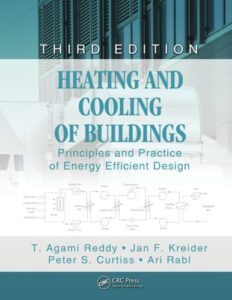Heating and cooling of buildings : principles and practice of energy efficient design
Heating and cooling of buildings : principles and practice of energy efficient design
Heating and Cooling of Buildings: Principles and Practice of Energy Efficient Design, Third Edition is structured to provide a rigorous and comprehensive technical foundation and coverage to all the various elements inherent in the design of energy efficient and green buildings. Along with numerous new and revised examples, design case studies, and homework problems, the third edition includes the HCB software along with its extensive website material, which contains a wealth of data to support design analysis and planning. Based around current codes and standards, the Third Edition explores the latest technologies that are central to design and operation of today’s buildings. It serves as an up-to-date technical resource for future designers, practitioners, and researchers wishing to acquire a firm scientific foundation for improving the design and performance of buildings and the comfort of their occupants. For engineering and architecture students in undergraduate/graduate classes.
You can also Read Principles of Sustainable Energy Systems
Heating and cooling of buildings : principles and practice of energy efficient design Content
Content: 1. Background of the building sector and energy use patterns —
2. Basic thermal science —
3. Human thermal comfort and indoor air quality —
4. Solar radiation —
5. Heat gains through windows —
6. Infiltration and natural ventilation —
7. Steady-state heat flows —
8. Transient heat flow through building elements —
9. Heating and cooling design load calculations —
10. Simplified annual energy estimation methods and inverse modeling —
11. Description of typical building HVAC systems and components —
12. Thermal principles relevant to equipment and systems —
13. Psychrometric properties and processes —
14. Chillers and heat pump cycles and systems —
15. Combustion heating equipment and systems —
16. Pumps, fans, and system interactions —
17. Cooling system equipment —
18. Hydronic distribution equipment and systems —
19. All-air systems —
20. Room air distribution and hybrid secondary systems —
21. HVAC control systems —
22. Lighting and daylighting —
23. Costin and economic analysis —
24. Design for energy efficiency.
Download
Heating and cooling of buildings : principles and practice of energy efficient design
Heating and cooling of buildings : principles and practice of energy efficient design

Comments are closed.